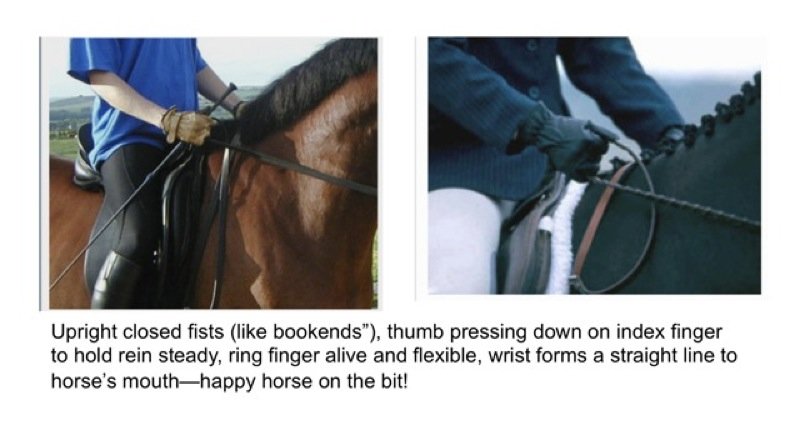Want to improve your riding? Improve your hands.
Some years ago, I was an invited speaker at a meeting of the American Riding Instructors Association. In his talk to the Association, George Morris, the famed jumping instructor and competitor, used the term "educated hands" to describe this concept. In order to get the most from your riding--whether it is dressage, jumping, or hacking out--develop "educated hands", hands that feel the horse's mouth.
IMAGINE YOU ARE A HORSE
The most important from the horse's point of view is the way the rider communicates with the horse's mouth.
Horse reins are not objects to be grabbed, leaned on, yanked, or pulled. They are a line of communication between you and your horse.
When riders hold the reins incorrectly, they end up losing connection with their horses and (too often) punishing their mounts unintentionally. Here is the most common error and how to correct it.
COCKED OR FLATTENED WRISTS
Many riders hold the reins with their wrists cocked or flattened. If you hold your reins in either way, you will find yourself pulling and see-sawing on your horses mouth with unfeeling, dead hands. The result will be one very unhappy horse with a very hard mouth. Your horse may duck behind the bit to avoid that “dead feeling” or lean on your hands to try to stabilize all that unpleasant movement.
THE CORRECTION
If instead you want your horse to be consistently “on the bit”—face on vertical and steady contact with the rider’s hands--try holding the reins this way: Position your wrists vertically (like bookends) and close your hands into fists so that the rein is held steady between the thumb and forefinger while your ring finger “feels” the horse’s mouth.
If instead you want your horse to be consistently “on the bit”—face on vertical and steady contact with the rider’s hands--try holding the reins this way: Position your wrists vertically (like bookends) and close your hands into fists so that the rein is held steady between the thumb and forefinger while your ring finger “feels” the horse’s mouth.
Happy Riding!
Copyright Denise Cummins, PhD, May 1, 2010; updated May 29, 2024
The Thinking Equestrian
As long as you’re here, check these out!
Equestrian Products That Make Your Riding and Horse Care Easier and Better!
Tips for Improving Your Riding
How to make your horse more forward
How to Feel More Secure During Lunge Lessons
Get Fit To Ride!
Copyright Denise Cummins, PhD, May 1, 2010; updated May 29, 2024
The Thinking Equestrian
As long as you’re here, check these out!
Equestrian Products That Make Your Riding and Horse Care Easier and Better!
Tips for Improving Your Riding
How to make your horse more forward
How to Feel More Secure During Lunge Lessons
Get Fit To Ride!


